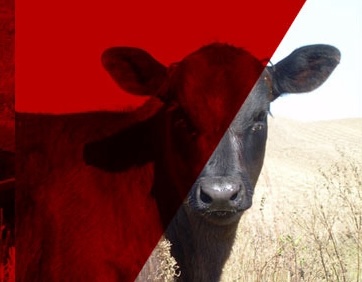The horn fly (Figure 1) is one of the most damaging pests of pasture and rangeland cattle across the U.S. Adult horn flies are blood-feeding insects that take an average of 30 blood meals per day. Their populations can build rapidly and often exceed the Economic Injury Level (EIL) defined as 200 flies per animal (Figure 2). Once fly numbers surpass this threshold, cattle experience reduced weight gain and milk production due to fly-induced stress and altered grazing behavior.

Observing your cattle during summer months is key to detecting fly pressure. Are they constantly tossing their heads, swishing their tails, or twitching their skin (Figure 3)? These are clear signs of fly irritation and an indication that a more effective control strategy may be needed.

In the U.S. alone, cattle producers lose over $1 billion annually due to horn fly infestations. With fly season approaching, now is the time to evaluate and refine your horn fly management plan for 2025. If your 2024 control efforts underperformed, consider adjusting your approach. The best control method will depend on several factors including efficacy, cost, convenience, and your current herd management practices.
It’s also important to remember that horn flies can migrate from neighboring untreated herds, masking the effectiveness of your efforts and increasing fly pressure. For this reason, a comprehensive, integrated fly control program is recommended. Such a program may include:
1. Insecticide Ear Tags
- Cattle should receive the number of tags recommended on the product label.
- Tagging just the calf, and not the cow, will not provide the desired level of control.
- Rotate active ingredients each year to help manage resistance.
- For maximum effect, apply tags in late May or early June and remove them in the fall.
2. Pour-ons and Sprays
- Flexible and useful for rapid knockdown.
- May require reapplication every 2–3 weeks.
- Mist blower sprayers and automatic sprayers can reduce labor and improve application efficiency.
3. Feed-through Products (IGRs)
- Work by disrupting the horn fly life cycle in manure.
- It should be in use 30 days before the start of fly season.
- Most effective in closed herds with consistent intake.
- Less effective when nearby cattle remain untreated.
4. Dust bags
- Bags should be located, so cattle must pass under them.
- Studies have shown that bags not forced-used, provide 25 to 50% less control.
- One dusting location with two bags treats approximately 50 to 60 cows.
5. Back rubbers and Oilers
- More effective when placed in a force-use arrangement.
- Do not use motor oil to dilute the insecticide; this will harm cattle.
6. Compressed Air Application
- Applies an individual capsule of insecticide (VetCap) to an animal, providing between 10 to 35 days of control.
- VetCaps can be used on cattle weighing at least 600 lbs.
7. Natural Products - Garlic
- It has been theorized that the strong odors emitted from the skin of animals fed garlic-based products are due to volatile organosulfur compounds formed during the metabolism of garlic. These metabolites, such as diallyl disulfide and allyl methyl sulfide, are absorbed into the bloodstream and transported throughout the body, eventually being excreted through the skin and breath. The presence of these pungent sulfurous compounds on the skin surface is thought to act as a natural repellent, deterring biting flies from landing or taking a blood meal (Maia and Moore, 2011).
- Commercial products normally contain a 2% concentration of garlic powder.
8. Mechanical Control – Bruce Walk-through Fly Trap
- Physically traps flies as cattle walk through the trap (Figure 4).
- Best placed in a forced-use situation, where cattle must pass through on a regular basis.
- Requires a period of animal acclimation.
- For blueprints, contact me at dboxler1@unl.edu or 308-696-6721.

Managing Insecticide Resistance in Pasture Fly Control
No matter which livestock fly control product or application method you use, it's important to plan for insecticide resistance. Over time, repeated use of the same type of insecticide can lead to reduced effectiveness as flies develop resistance. A key strategy to manage resistance is rotating products based on their Mode of Action (MoA).
The Insecticide Resistance Action Committee (IRAC) classifies insecticides into groups based on how they affect the target pest’s biology. These IRAC MoA group numbers help producers choose products that kill insects in different ways. Always check the “Insecticide Resistance Management” section on the product label—it lists the IRAC group number and its mode of action.
Example:
- Permectrin II and Cylence Ultra are Group 3A insecticides – they disrupt nerve function by acting on sodium channels.
- Co-Ral Fly and Tick Spray and Prolate/Lintox HD belong to Group 1B – they inhibit acetylcholinesterase, an enzyme critical for nerve signal transmission.
Best Practices for Resistance Management
- Rotate between insecticide MoA groups each fly season, and if possible, within the season.
- Avoid repeated use of insecticides from the same MoA group.
- Choose products with different MoAs for back-to-back treatments or when switching application methods (e.g., ear tags vs sprays).
- Always follow label directions and use the recommended dose to ensure effective control and avoid under-dosing, which can accelerate resistance.
Implementing an insecticide rotation strategy not only helps extend the life of available products but also improves fly control, enhances animal welfare, and protects your bottom line.
Literature Cited
Maia, M. F., & Moore, S. J. (2011). Plant-based insect repellents: a review of their efficacy, development and testing. Malaria Journal, 10, S1-S11.https://doi.org/10.1186/1475-2875-10-S1-S11
Article by David Boxler, Nebraska Extension Livestock Entomologist.

